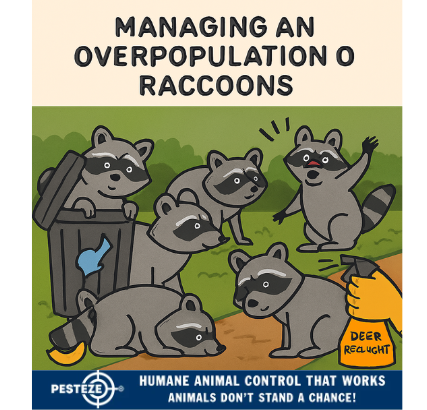MANAGING AN OVERPOPULATION OF RACCOONS

MANAGING AN OVERPOPULATION OF RACCOONS
SUMMARY
Raccoon overpopulation can lead to property damage, health risks, and increased human-wildlife conflict. These intelligent, adaptable animals thrive in urban and suburban environments, often scavenging for food and nesting in attics or crawl spaces. This guide provides safe, legal, and humane strategies to manage raccoon populations effectively. Whether you're a homeowner, property manager, or community leader, understanding how to control raccoon numbers is key to maintaining public safety and ecological balance.
FEATURES
-
Recognizing Overpopulation Signs: Identify increased sightings, noise, and property damage.
-
Securing Food Sources: Eliminate attractants like open trash bins and pet food.
-
Habitat Modification: Remove nesting sites and block access to buildings.
-
Humane Deterrents: Use motion-activated lights, sprinklers, and scent repellents.
-
Legal Trapping Guidelines: Understand local laws before attempting relocation or removal.
-
Community Collaboration: Work with neighbors and officials for long-term solutions.
GUIDE DESCRIPTION
Raccoons are highly adaptable mammals that can quickly become a nuisance when their population grows unchecked. Overpopulation often results in increased property damage, aggressive behavior, and the spread of diseases such as rabies and leptospirosis. This guide outlines responsible and effective methods for managing raccoon overpopulation without causing harm or violating wildlife laws.
The first step is recognizing the signs. Frequent raccoon sightings during daylight hours, overturned trash cans, garden destruction, and attic noises are common indicators. Once identified, take immediate action to reduce attractants. Secure garbage bins with locking lids, feed pets indoors, and clean up fallen fruit or birdseed.
Modify the habitat to discourage nesting. Seal entry points to attics, sheds, and crawl spaces using hardware cloth or metal flashing. Trim tree branches that provide roof access and remove woodpiles or debris that could serve as shelter.
Humane deterrents can help shift raccoons away from your property. Motion-activated lights and sprinklers startle them without harm. Scent repellents like ammonia-soaked rags or commercial raccoon deterrents can also be effective when placed near entry points.
If removal is necessary, consult local wildlife authorities. Many regions have strict laws regarding trapping and relocation. Licensed professionals can assess the situation and use approved methods to remove raccoons safely.
Long-term success often requires community involvement. Educate neighbors about raccoon-safe practices and work with local officials to implement broader control measures, such as public trash management and wildlife monitoring.
By following these steps, you’ll reduce raccoon-related issues while promoting humane and legal wildlife management. A balanced approach ensures safety, cleanliness, and coexistence.
- Amy Chang


Comments 0